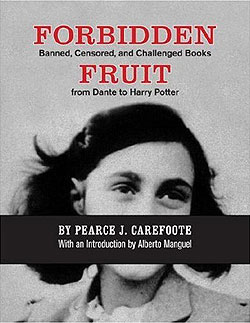Forbidden Fruit: Banned, Censored, and Challenged Books from Dante to Harry Potter
Published on January 30th, 2012 in: Book Reviews, Books, Canadian Content, Issues, Oh No You Didn't |When you think of banned books, you might think of Henry Miler’s Tropic of Cancer (1934), J.D. Salinger’s The Catcher In The Rye (1951), Kurt Vonnegut’s Slaughterhouse Five (1969), or Margaret Atwood’s The Handmaid’s Tale (1985). However, the practice of censorship and banning books reaches back to Socrates and the fifth century BCE. As Pearce J. Carefoote’s Forbidden Fruit: Banned, Censored, and Challenged Books from Dante to Harry Potter explains, the practice did not end when the Middle Ages gave way to the Renaissance.

Perhaps unsurprisingly, the biggest and most powerful proponent of censorship has been the Catholic Church. In 1557, Pope Paul IV instituted the first of many editions of the Index librorum prohibitorum, also known as the Index of Forbidden Books. This Index continued until 1948 and included 42 revised editions. Although the Index was abolished in 1966, as recently as 1983, the Church issued a Code of Canon Law which required Catholic authors to obtain a nihil obstat (“nothing stands in the way”) which gives “permission to publish a book, granted by an official censor who, upon examining it, has certified that it contains nothing contrary to faith or morals.”
What may be more of a shock is the description of the powerful Comstock Law, the Federal Anti-Obscenity Act, passed by the United States in 1873. This law “ostensibly banned the sale of items published to promote contraception in the United States.” Although the Act was “abandoned” in the 1930s (not long after women obtained the right to vote), “local ordinances remained in effect in many jurisdictions until Congress officially repealed the act in 1970,” (around the same time that birth control pills were legally made available to unmarried women in all US states). Let that sink in for a minute.
Forbidden Fruit provides many examples of banned and censored books from the fifteenth century to the present time and includes brief descriptions of each book and why it was contentious. These examples are further broken down into categories: Religion & Science, Politics & Philosophy, Literature as Threat to Social Order, and The Canadian Experience.
It’s quite eye opening to witness the long, tenacious arm of censorship throughout the centuries and realize that it is hardly a new phenomenon. While the list of censored books provides a good primer for those looking to include some of the world’s most significant written works in their library queue, the most rewarding part of Carefoote’s book is the explanation of why censorship exists and most importantly, why it has always been and will always be a bad idea.
Carefoote outlines the “five irrefutable values of literature” as well as the three main areas for challenging literature, and successfully conveys how important the printing press has been in the history of literature as well as censorship itself. In fact, it was Gutenberg’s invention of this device around 1440 that caused such an uproar in the first place. As he states:
“The hierarchy perceived that it could help the Church disseminate her message more effectively than any other instrument previously available; it also recognized that the press could potentially threaten her previously uncontested domination over thought and belief.”
This “elitist premise” that “the uneducated masses need protection from ideas” seems frighteningly relevant in the Internet age, particularly regarding the SOPA/PIPA legislation and net neutrality. (For more on these topics, please see this issue’s Editorial.) Carefoote points out sarcastically that “suppression is an acceptable way of dealing with controversy” and argues that we should “preserve the historical records even if it is offensive.”
Perhaps the best commentary on the issue comes from Blair Fraser, and is quoted in Forbidden Fruit. In a 1949 article in Maclean‘s (“Our hush hush censorship”), Fraser wrote:
“No one is qualified to be a censor, for censorship is itself an outrage and a contradiction of freedom. The essence of free speech and free press is that a man may say what he likes, print what he likes, and then stand responsible for it after it has been uttered.”
Time limit is exhausted. Please reload the CAPTCHA.